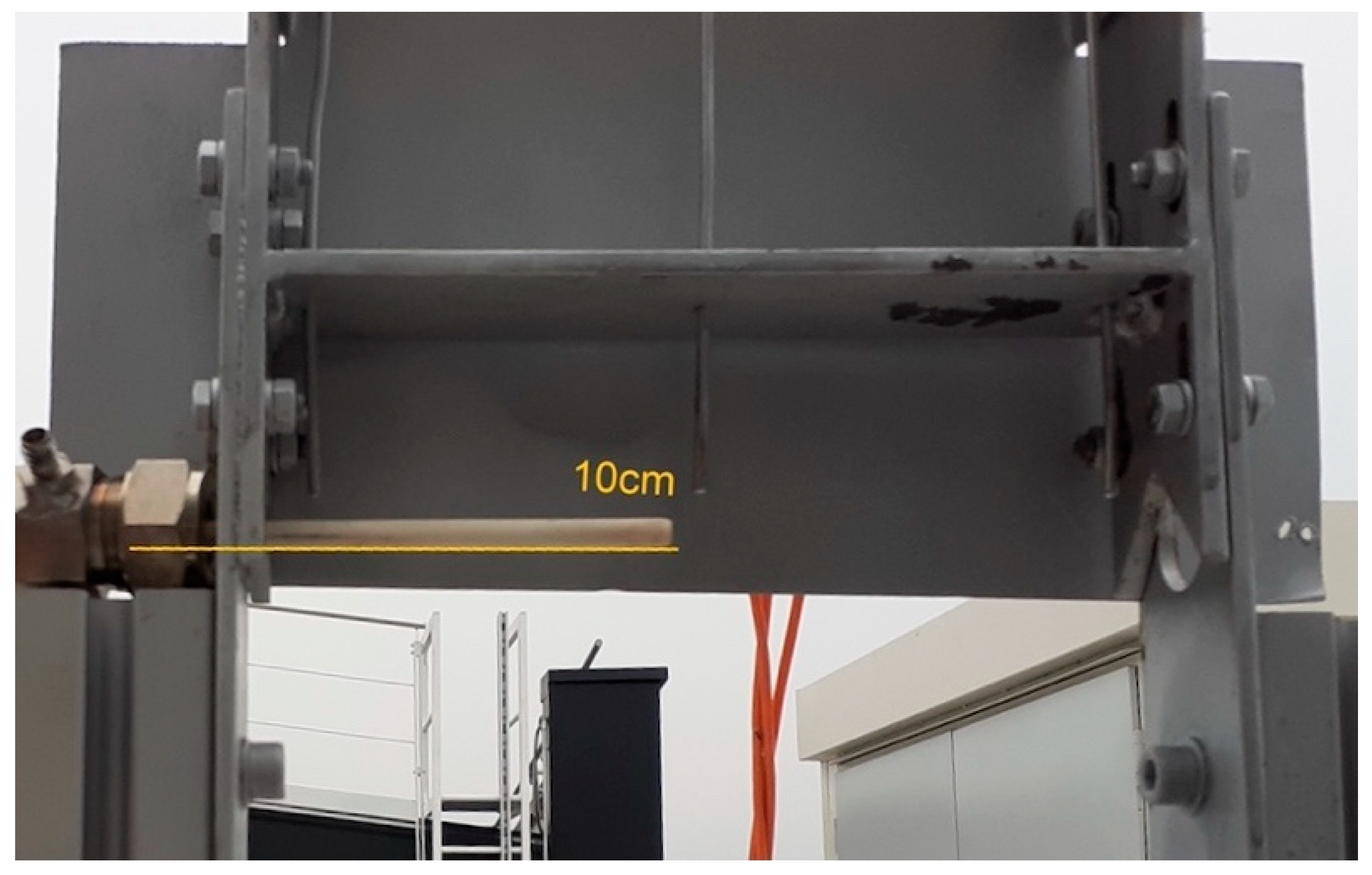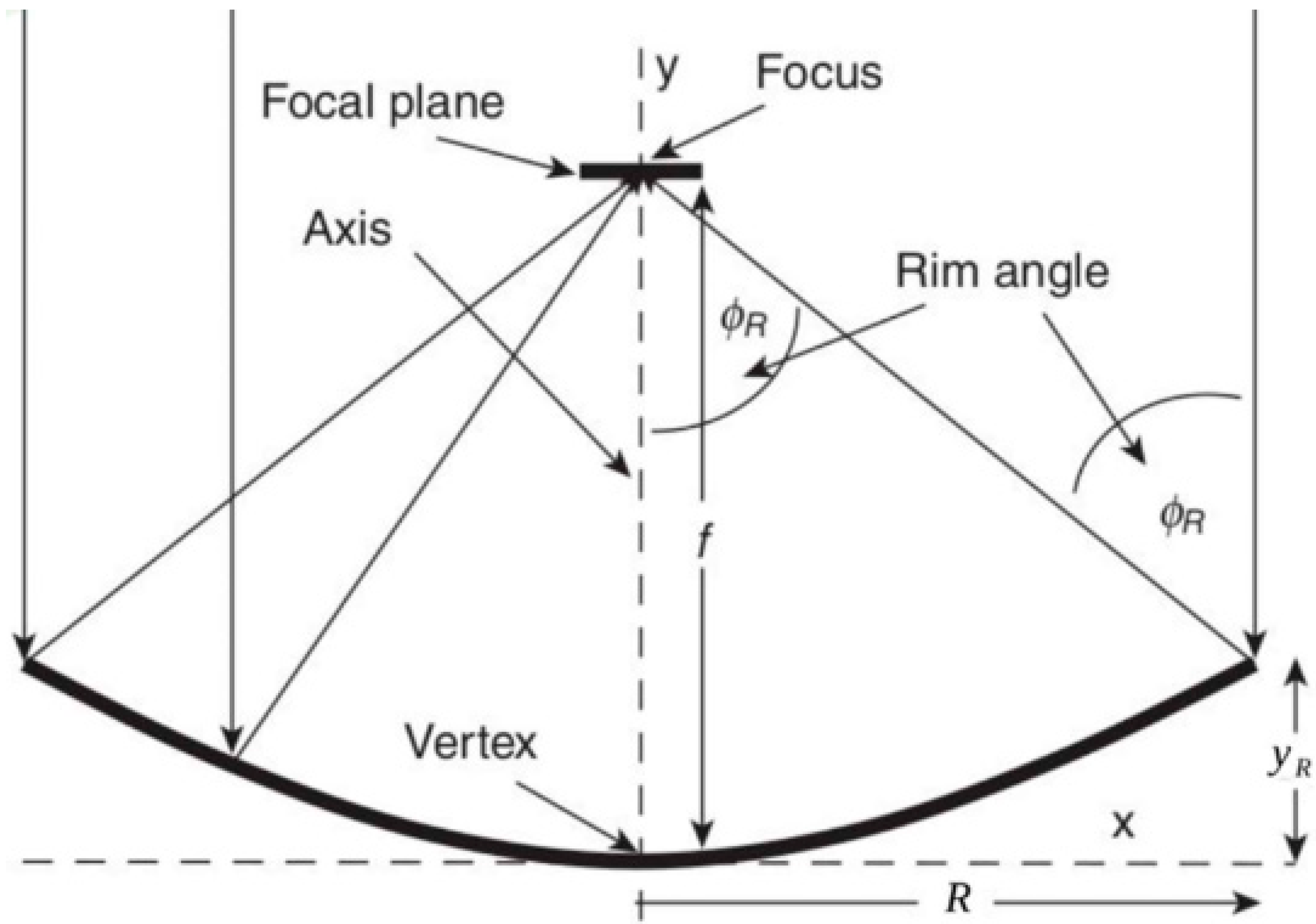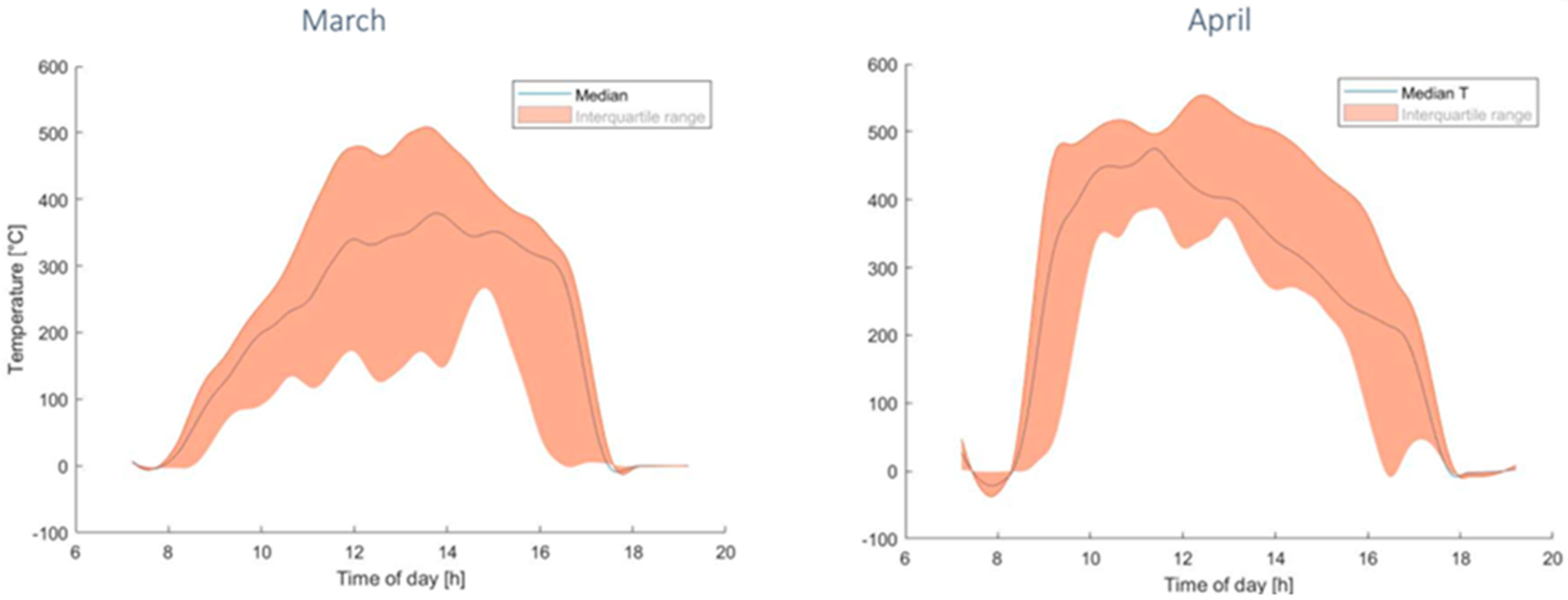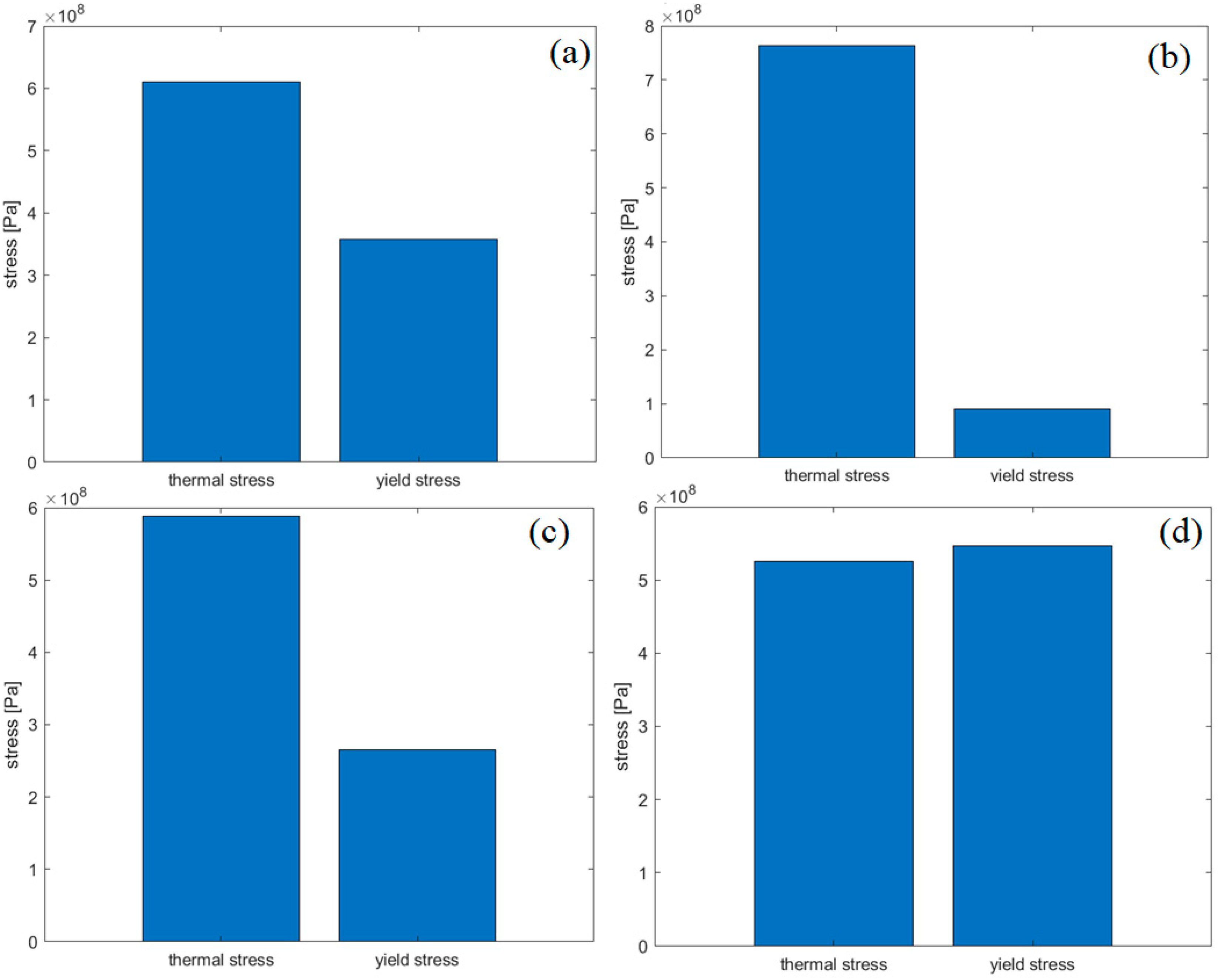Solar Disc Concentrator: Material Selection for the Receiver
Abstract
:1. Introduction
2. Materials and Methods
- Gas flowing inside the receiver has been approximated to air, with minimum airflow fixed at = 1.66 × 10−5 m3/s (calm air condition);
- Heat transport in the fluid (air) due to only advection, while thermal diffusion phenomena in this region are considered negligible;
- Fully developed airflow;
- Spatially and temporally constant properties assessed at a temperature of 800 °C;
- One-way heat transfer along the axial direction;
- Average radiation equal to I0 = 800 W/m2.
3. Results and Discussion
3.1. Preliminary Temperature Receiver Recording
3.2. Thermal Stress Induced by the Temperature on the Receiver
4. Conclusions
- Alloy 625 was considered, and the implemented model showed the collapse of the structure. This result was experimentally verified, as reported in Figure 6b.
- Alloy 800H was considered, and the implemented model showed the collapse of the structure. The thermal stress was higher than the yield stress.
- Haynes 230 was considered, and the implemented model showed the collapse of the structure. This result was experimentally verified, as reported in Figure 6c.
- Inconel 740H was considered, and the implemented model showed the non-collapse of the structure. This result was experimentally verified, as reported in Figure 6a. This could be due to its microstructure, even in high temperatures at a long duration, but in stable temperature conditions, as shown by Zielinski et al. [44].
Author Contributions
Funding
Data Availability Statement
Conflicts of Interest
Nomenclature
| yield stress (Pa) | |
| thermally induced stress (Pa) | |
| coefficient of linear expansion (m/mK) | |
| Aa | concentrator area () |
| Ar | receiver area () |
| Ari | internal receiver area () |
| cp | specific heat at constant pressure (J/kg K) |
| CR0 | optical concentration ratio |
| d | receiver diameter (m) |
| D | solar concentrator diameter (m) |
| E | elastic modulus of material (Pa) |
| f | focal length (m) |
| I0 | constant solar radiation (W/) |
| Ir | receiver flow from the solar concentration factor (W/) |
| k | thermal conductivity (W/mK) |
| L | receiver length (m) |
| m | subscript for the material side |
| heat transfer fluid mass flow rate (kg/s) | |
| Ta | temperature for the air fluid (°C) |
| Tin | heat transfer fluid inlet temperature (°C) |
| Tm | material temperature of the receiver (°C) |
| Tout | heat transfer fluid outlet temperature (°C) |
| Uc | receiver heat transfer coefficient (W/ K) |
| Vm | receiver volume (m3) |
| Va | internal receiver volume (m3) |
| α | solar altitude (rad) |
| γ | intercept factor |
| μ | dynamic viscosity (Pa s) |
| ρ | density (kg/) |
| τ | receiver coverage transmittance |
| ϕrim | angle between reflected radiation and vertex-focus junction |
| ψ1 | slope error |
| ψ2 | solar radius error |
| ψ3 | error in solar tracking |
| αr | absorbance receiver |
| η0 | optimal concentrator performance |
| ηreceiver | receiver performance |
| τb | direct optical length |
| τd | diffused optical length |
References
- Islam, M.T.; Huda, N.; Abdullah, A.B.; Saidur, R. A comprehensive review of state-of-the-art concentrating solar power (CSP) technologies: Current status and research trends. Renew. Sustain. Energy Rev. 2018, 91, 987–1018. [Google Scholar] [CrossRef]
- Chen, Q.; Wang, Y.; Zhang, J.; Wang, Z. The Knowledge Mapping of Concentrating Solar Power Development Based on Literature Analysis Technology. Energies 2020, 13, 1988. [Google Scholar] [CrossRef]
- IEA. Solar. n.d. Available online: https://www.iea.org/energy-system/renewables/solar-pv (accessed on 13 July 2023).
- IEA. Renewable Electricity—Renewables 2022—Analysis. n.d. Available online: https://www.iea.org/reports/renewables-2022/renewable-electricity (accessed on 13 July 2023).
- Sharma, V.K.; Singh, R.; Gehlot, A.; Buddhi, D.; Braccio, S.; Priyadarshi, N.; Khan, B. Imperative Role of Photovoltaic and Concentrating Solar Power Technologies towards Renewable Energy Generation. Int. J. Photoenergy 2022, 2022, e3852484. [Google Scholar] [CrossRef]
- Alami, A.H.; Olabi, A.G.; Mdallal, A.; Rezk, A.; Radwan, A.; Rahman, S.M.A.; Shah, S.K.; Abdelkareem, M.A. Concentrating solar power (CSP) technologies: Status and analysis. Int. J. Thermofluids 2023, 18, 100340. [Google Scholar] [CrossRef]
- Soomro, M.I.; Mengal, A.; Memon, Y.A.; Khan, M.W.A.; Shafiq, Q.N.; Mirjat, N.H. Performance and Economic Analysis of Concentrated Solar Power Generation for Pakistan. Processes 2019, 7, 575. [Google Scholar] [CrossRef]
- Borge-Diez, D.; Rosales-Asensio, E.; Palmero-Marrero, A.I.; Acikkalp, E. Optimization of CSP Plants with Thermal Energy Storage for Electricity Price Stability in Spot Markets. Energies 2022, 15, 1672. [Google Scholar] [CrossRef]
- Kuravi, S.; Goswami, Y.; Stefanakos, E.K.; Ram, M.; Jotshi, C.; Pendyala, S.; Trahan, J.; Sridharan, P.; Rahman, M.; Krakow, B. Thermal energy storage for concentrating solar power plants. Technol. Innov. 2012, 14, 81–91. [Google Scholar] [CrossRef]
- Qoaider, L.; Liqreina, A. Optimization of dry cooled parabolic trough (CSP) plants for the desert regions of the Middle East and North Africa (MENA). Sol. Energy 2015, 122, 976–985. [Google Scholar] [CrossRef]
- Abdelkareem, M.A.; El Haj Assad, M.; Sayed, E.T.; Soudan, B. Recent progress in the use of renewable energy sources to power water desalination plants. Desalination 2018, 435, 97–113. [Google Scholar] [CrossRef]
- Mohammadi, K.; Saghafifar, M.; Ellingwood, K.; Powell, K. Hybrid concentrated solar power (CSP)-desalination systems: A review. Desalination 2019, 468, 114083. [Google Scholar] [CrossRef]
- Agrafiotis, C.; Roeb, M.; Sattler, C. A review on solar thermal syngas production via redox pair-based water/carbon dioxide splitting thermochemical cycles. Renew. Sustain. Energy Rev. 2015, 42, 254–285. [Google Scholar] [CrossRef]
- Chuayboon, S.; Abanades, S. An overview of solar decarbonization processes, reacting oxide materials, and thermochemical reactors for hydrogen and syngas production. Int. J. Hydrogen Energy 2020, 45, 25783–25810. [Google Scholar] [CrossRef]
- Sharma, J.P.; Kumar, R.; Ahmadi, M.H.; Mukhtar, A.; Yasir, A.S.H.M.; Sharifpur, M.; Ongar, B.; Yegzekova, A. Chemical and thermal performance analysis of a solar thermochemical reactor for hydrogen production via two-step WS cycle. Energy Rep. 2023, 10, 99–113. [Google Scholar] [CrossRef]
- Barreto, G.; Canhoto, P. Modelling of a Stirling engine with parabolic dish for thermal to electric conversion of solar energy. Energy Convers. Manag. 2017, 132, 119–135. [Google Scholar] [CrossRef]
- Carrillo Caballero, G.E.; Mendoza, L.S.; Martinez, A.M.; Silva, E.E.; Melian, V.R.; Venturini, O.J.; del Olmo, O.A. Optimization of a Dish Stirling system working with DIR-type receiver using multi-objective techniques. Appl. Energy 2017, 204, 271–286. [Google Scholar] [CrossRef]
- Mancini, T.; Heller, P.; Butler, B.; Osborn, B.; Schiel, W.; Goldberg, V.; Buck, R.; Diver, R.; Andraka, C.; Moreno, J. Dish-Stirling Systems: An Overview of Development and Status. J. Sol. Energy Eng. 2003, 125, 135–151. [Google Scholar] [CrossRef]
- Papurello, D.; Bertino, D.; Santarelli, M. CFD Performance Analysis of a Dish-Stirling System for Microgeneration. Processes 2021, 9, 1142. [Google Scholar] [CrossRef]
- Bose, A.; Farooqui, A.; Ferrero, D.; Santarelli, M.; Llorca, J. Thermodynamic assessment of non-catalytic Ceria for syngas production by methane reduction and CO2 + H2O oxidation. Mater. Renew. Sustain. Energy 2019, 8, 5. [Google Scholar] [CrossRef]
- Farooqui, A.; Bose, A.; Boaro, M.; Llorca, J.; Santarelli, M. Assessment of integration of methane-reduced ceria chemical looping CO2/H2O splitting cycle to an oxy-fired power plant. Int. J. Hydrogen Energy 2020, 45, 6184–6206. [Google Scholar] [CrossRef]
- Borghero, L.; Bressan, M.; Ferrero, D.; Santarelli, M.; Papurello, D. Methane-Assisted Iron Oxides Chemical Looping in a Solar Concentrator: A Real Case Study. Catalysts 2022, 12, 1477. [Google Scholar] [CrossRef]
- Boretti, A. Which thermochemical water-splitting cycle is more suitable for high-temperature concentrated solar energy? Int. J. Hydrogen Energy 2022, 47, 20462–20474. [Google Scholar] [CrossRef]
- Li, J.-Q.; Kwon, J.-T.; Jang, S.-J. The Power and Efficiency Analyses of the Cylindrical Cavity Receiver on the Solar Stirling Engine. Energies 2020, 13, 5798. [Google Scholar] [CrossRef]
- Liu, S.; Yang, B.; Yu, X. Impact of installation error and tracking error on the thermal-mechanical properties of parabolic trough receivers. Renew. Energy 2023, 212, 197–211. [Google Scholar] [CrossRef]
- Erasmus, D.J.; Sánchez-González, A.; Lubkoll, M.; Craig, K.J.; von Backström, T.W. Thermal performance characteristics of a tessellated-impinging central receiver. Appl. Therm. Eng. 2023, 229, 120529. [Google Scholar] [CrossRef]
- Du, S.; Wang, Z.; Shen, S. Thermal and structural evaluation of composite solar receiver tubes for Gen3 concentrated solar power systems. Renew. Energy 2022, 189, 117–128. [Google Scholar] [CrossRef]
- Ricci, L.; Papurello, D. A Prediction Model for Energy Production in a Solar Concentrator Using Artificial Neural Networks. Int. J. Energy Res. 2023, 2023, 1–20. [Google Scholar] [CrossRef]
- Marra, A.; Santarelli, M.; Papurello, D. Solar Dish Concentrator: A Case Study at the Energy Center Rooftop. Int. J. Energy Res. 2023, 2023, 9658091. [Google Scholar] [CrossRef]
- Laporte-Azcué, M.; González-Gómez, P.A.; Rodríguez-Sánchez, M.R.; Santana, D. Material selection for solar central receiver tubes. Sol. Energy Mater. Sol. Cells 2021, 231, 111317. [Google Scholar] [CrossRef]
- Special Metals—INCONEL®. n.d. Available online: https://www.specialmetals.com/documents/technical-bulletins/inconel/ (accessed on 18 September 2023).
- Special Metals—INCOLOY®. n.d. Available online: https://www.specialmetals.com/documents/technical-bulletins/incoloy/ (accessed on 18 September 2023).
- Principal Features. n.d. Available online: https://www.haynesintl.com/alloys/alloy-portfolio_/High-temperature-Alloys/HAYNES-230-ALLOY/principal-features.aspx (accessed on 18 September 2023).
- Alloy 316H Stainless Steel Plate, Sandmeyer Steel. n.d. Available online: https://www.sandmeyersteel.com/316-316L.html (accessed on 18 September 2023).
- Montà, E.; Santarelli, M.; Papurello, D. Synthetic-Gas Production through Chemical Looping Process with Concentrating Solar Dish: Temperature-Distribution Evaluation. Processes 2022, 10, 1698. [Google Scholar] [CrossRef]
- Kumar Goyal, R.; Muthusamy, E. Thermo-physical properties of heat storage material required for effective heat storage and heat transfer enhancement techniques for the solar cooking applications. Sustain. Energy Technol. Assess. 2023, 56, 103078. [Google Scholar] [CrossRef]
- Al-Nimr, M.; Khashan, S.A.; Al-Oqla, H. Novel techniques to enhance the performance of Stirling engines integrated with solar systems. Renew. Energy 2023, 202, 894–906. [Google Scholar] [CrossRef]
- Mataveli Suave, L.; Cormier, J.; Bertheau, D.; Villechaise, P.; Soula, A.; Hervier, Z.; Hamon, F. High temperature low cycle fatigue properties of alloy 625. Mater. Sci. Eng. A 2016, 650, 161–170. [Google Scholar] [CrossRef]
- Cao, Y.; Di, H.; Zhang, J.; Yang, Y. Dynamic behavior and microstructural evolution during moderate to high strain rate hot deformation of a Fe–Ni–Cr alloy (alloy 800H). J. Nucl. Mater. 2015, 456, 133–141. [Google Scholar] [CrossRef]
- Cao, Y.; Di, H.S.; Misra, R.D.K.; Zhang, J. Hot Deformation Behavior of Alloy 800H at Intermediate Temperatures: Constitutive Models and Microstructure Analysis. J. Mater. Eng. Perform. 2014, 23, 4298–4308. [Google Scholar] [CrossRef]
- Pataky, G.J.; Sehitoglu, H.; Maier, H.J. Creep deformation and mechanisms in Haynes 230 at 800 °C and 900 °C. J. Nucl. Mater. 2013, 443, 484–490. [Google Scholar] [CrossRef]
- Kim, D.-M.; Kim, C.; Yang, C.-H.; Park, J.-U.; Jeong, H.-W.; Yim, K.-H.; Hong, H.-U. Heat treatment design of Inconel 740H superalloy for microstructure stability and enhanced creep properties. J. Alloys Compd. 2023, 946, 169341. [Google Scholar] [CrossRef]
- deBarbadillo, J.J. 14—INCONEL alloy 740H. In Materials for Ultra-Supercritical and Advanced Ultra-Supercritical Power Plants; Di Gianfrancesco, A., Ed.; Woodhead Publishing: Sawston, UK, 2017; pp. 469–510. ISBN 978-0-08-100552-1. [Google Scholar]
- Zieliński, A.; Sroka, M.; Dudziak, T. Microstructure and Mechanical Properties of Inconel 740H after Long-Term Service. Materials 2018, 11, 2130. [Google Scholar] [CrossRef]






| Name | Expression | Value | Description |
|---|---|---|---|
| 0.92 m | Focal length | ||
| 45° | 0.7854 rad | Rim Angle | |
| - | 2.37 m | Diameter of the concentrator | |
| 2.54 m2 | Capturing Area of the concentrator | ||
| d | - | 18.06 × 10−3 m | Receiver diameter (outer) |
| L | - | 0.2 m | Receiver length |
| CR0 | - | 8013 | Optical concentration ratio |
| Inconel 740H | Alloy 625 | Alloy 800H | Haynes 230 | |
|---|---|---|---|---|
| T melting | 1288–1362 °C | 1290–1350 °C | 1357–1385 °C | 1301–1371 °C |
| Elastic modulus (E) | 186 GPa (@T = 600 °C) 178 GPa (@T = 700 °C) 169 GPa (@T = 800 °C) | 170 GPa (@T = 650 °C) 160 GPa (@T = 760 °C) 148 GPa (@T = 870 °C) | 157.7 GPa (@T = 600 °C) 150.1 GPa (@T = 700 °C) 141.3 GPa (@T = 800 °C) | 175 GPa (@T = 600 °C) 168 GPa (@T = 700 °C) 159 GPa (@T = 800 °C) |
| Yield strength () | 742 MPa (@Tamb) 608 Mpa (@T = 700 °C) 547 MPa (@T = 800 °C) | 414–517 MPa (annealed, @Tamb) 357.2 MPa (@T = 800 °C) | 150 MPa (@Tamb) 109 MPa (@T = 700 °C) 90 MPa (@T = 760 °C) | 415 MPa (@Tamb) 265 MPa (@871 °C) 294 Mpa (@T = 1000 °C) |
| Coefficient of linear expansion () | 15.7 | 15.5 | 18 | 15.3 |
| Density (ρ) | 8050 kg/ | 8422 kg/ | 7940 kg/m3 | 8968 kg/ |
| Specific heat (c) | 573 J/kgK | 600 J/kgK | 460 J/kgK | 465 J/kgK |
| Thermal conductivity (k) | 22.1 W/mK | 15.7 W/mK | 11.5 W/mK | 16.4 W/mK |
| Material | Biot |
|---|---|
| Alloy 625 | 0.0019 |
| Alloy 800H | 0.0026 |
| Haynes 230 | 0.0018 |
| Inconel 740H | 0.0013 |
Disclaimer/Publisher’s Note: The statements, opinions and data contained in all publications are solely those of the individual author(s) and contributor(s) and not of MDPI and/or the editor(s). MDPI and/or the editor(s) disclaim responsibility for any injury to people or property resulting from any ideas, methods, instructions or products referred to in the content. |
© 2023 by the authors. Licensee MDPI, Basel, Switzerland. This article is an open access article distributed under the terms and conditions of the Creative Commons Attribution (CC BY) license (https://creativecommons.org/licenses/by/4.0/).
Share and Cite
Perrero, M.; Papurello, D. Solar Disc Concentrator: Material Selection for the Receiver. Energies 2023, 16, 6870. https://doi.org/10.3390/en16196870
Perrero M, Papurello D. Solar Disc Concentrator: Material Selection for the Receiver. Energies. 2023; 16(19):6870. https://doi.org/10.3390/en16196870
Chicago/Turabian StylePerrero, Margherita, and Davide Papurello. 2023. "Solar Disc Concentrator: Material Selection for the Receiver" Energies 16, no. 19: 6870. https://doi.org/10.3390/en16196870







